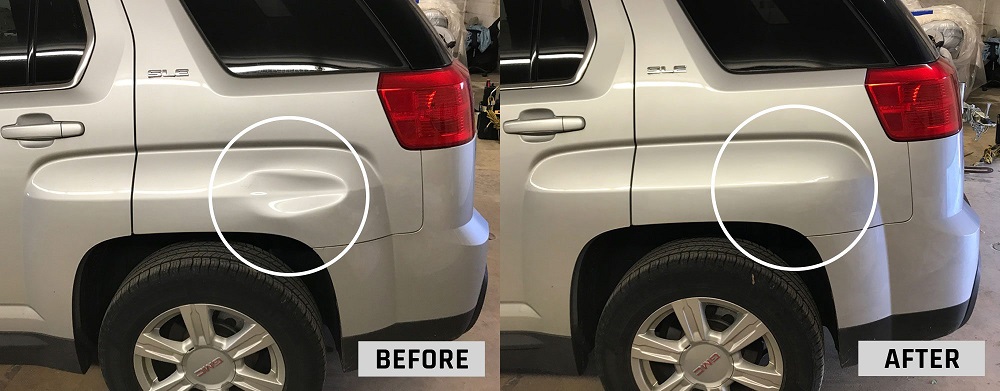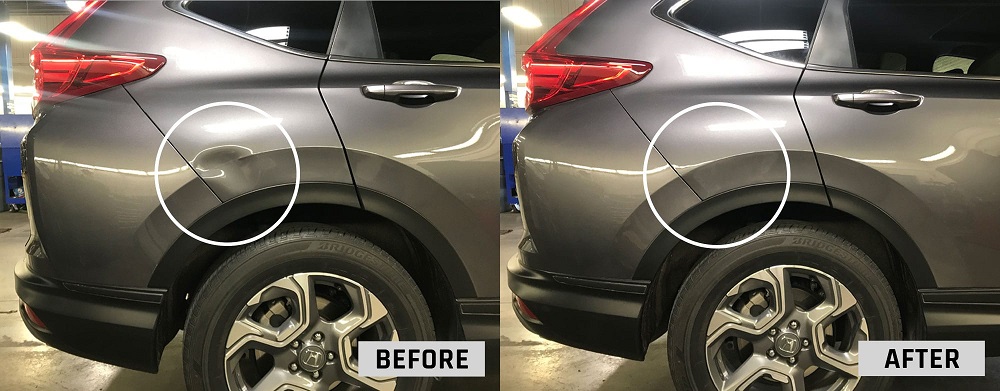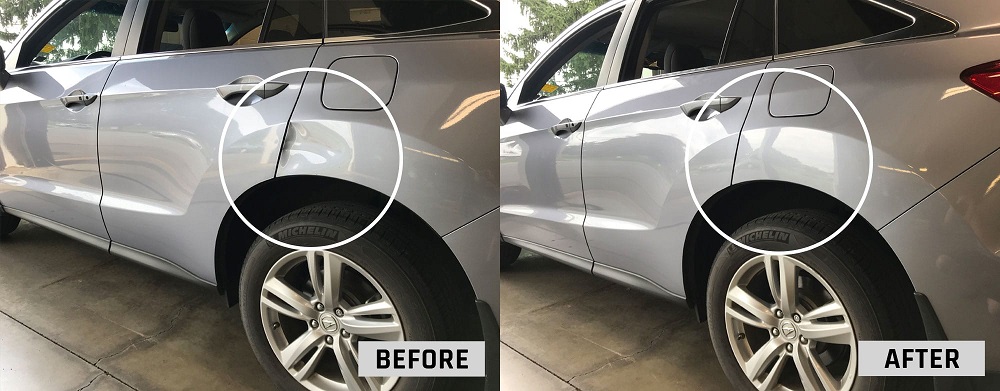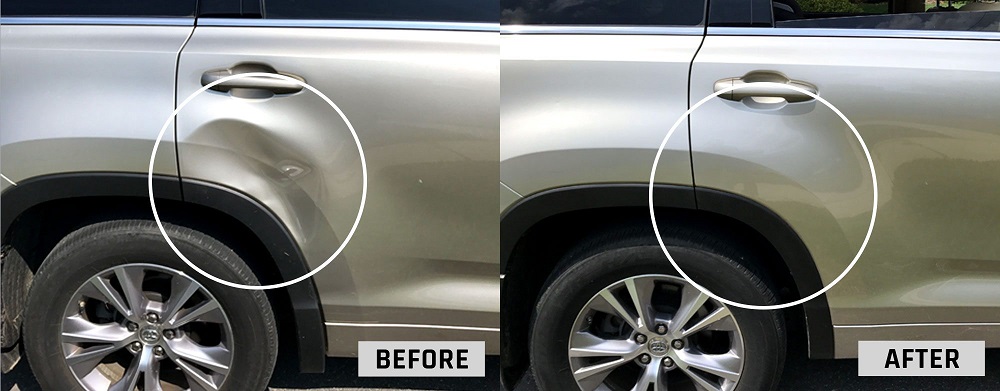Paintless Dent Repair in Kent
Are you looking for a quality
paintless dent repair? in Kent?
and at an affordable price?
Just Fill In The Form Below

Get Your Paintless Dent Repair Quote Today!
Repair My Dent in Kent
Just fill in our request form.
for a FREE no-obligation quote.
Simply enter your details or call:
Landline: 01843 800800
Mobile: 07507 010101
Remove Dents the Easy Way!
As a vehicle owner, you’ll know how frustrating it is to have a dent on your car; it not only looks terrible but can significantly reduce its resale value. Don’t worry. Help is at hand – Reclamet Repair and Refinish Ltd. can remove dents and help keep your car looking good and in tip-top condition.
Paintless dent repairs are also cost-effective, usually less than your insurance excess, so it protects your No Claims Bonus or hire car excess and saves the hassle of making a claim.
What Areas do we Cover?
Ashford • Birchington • Broadstairs • Canterbury • Chatham • Dartford • Deal • Ditton • Dover • Faversham • Folkestone • Gillingham • Gravesend • Hartley • Herne Bay • Hythe • Maidstone • Manston • Margate • Minster • Northfleet • Ramsgate • Rochester • Royal Tunbridge Wells • Sevenoaks • Sheerness • Sittingbourne • Swanley • Swanscombe • Thanet • Tonbridge • Whitstable.
5-Star Dent Repair Service
We guarantee a 5-star dent repair service for all vehicle makes and models, focusing on quality and affordability. Our highly trained support team offers a professional and friendly service to all customers
Best Workmanship and Quality
Dent Repair Testimonials
Don’t just take our word for it! Here are some repair reviews from our recent customers.
Contact our customer repair team today for a professional and friendly repair service.
Repair and Refinish Specialists
Before/After Repair Photos




Second to None Repair Service
Complete PDR Guide
Can PDR fix my dent?
If your vehicle has suffered from a nasty dent, be it a parking lot scar or an accident, it can usually be repaired using PDR. At Reclamet Repair and Refinish, our dent repair experts can fix most minor dents as long as the paint is intact and the dent isn’t too complex. With paintless dent repair, we can remove most dents, making it the a great way to make your car look new
If we can access the back area of a dent, we can often remove it using the Paintless Dent Repair (PDR) process. The best thing about PDR is that we don’t have to add body filler or repaint, nor do we need to disturb your vehicle’s factory paint during the repair process. This makes PDR a much faster and less intrusive way of repairing dents than traditional methods, including sanding down the body panel, adding filler, and repainting the panel.
If you’re looking for an affordable and time-efficient way to remove dents from your vehicle’s body panels, the paintless dent repair process is a viable option. This method is cheaper than repainting or traditional repairs, and most dents can be fixed quickly!
We understand you may still have questions regarding the paintless dent repair process. To help you better understand it, we have created an in-depth guide that answers many of the common questions about PDR. After reading this guide, you will have a clearer picture of the repair process and be able to determine whether PDR is a suitable option for your vehicle.
How do you fix different car dent shapes with PDR?
Each dent is unique in its own way. No two vehicles have identical shapes, and neither do the objects or other vehicles that could cause damage to your car. As a result, we come across an extensive range of dents that vary in shape and size. Whether a dent can be fixed through paintless dent repair or not depends on the shape of the dent.
Below are a few different factors to consider:
Dent complexity
Assessing its complexity is an important factor in determining if paintless dent repair is suitable for your dent. A more complex dent is more challenging to repair.
Dent creasing
If a dent is creased, it may not be possible to repair it with PDR. Though there are plenty of skilled PDR technicians globally, creases make restoring the body panel to its original shape challenging. A great way to understand the complexity of dent repair and how creasing affects it is by imagining squeezing a pop can or bottle. The theory also applies to vehicles. While different materials and paint properties are used, a round dent is easier to fix than a crease.
Many PDR technicians use specialized tools, such as picks, hammers, and equipment, to remove mild creasing dents. Traditional dent repair processes may be necessary to fix dents where paint is disturbed, and panel replacement may be required in severe cases.
Dent depth
When fixing dents in your car, it’s important to consider the dent’s depth. Generally, shallower dents are easier to repair than deeper ones. If a dent is deeper, more of the vehicle’s body panel will be affected, limiting its repairability and compromising the panel’s integrity. The panel is less likely to return to its original shape with deeper dents.
The elastic limit is the ability of your vehicle’s paint to stretch without cracking. The elasticity of car paint varies between manufacturers due to paint thickness and additives. Some vehicles have more flexible paint, allowing them to handle deeper and more complex dents without cracking. On the other hand, some vehicles have more brittle paint and a harder clear coat that will crack sooner when damaged. Therefore, the paint’s flexibility is essential when evaluating the potential damage caused by a dent.
When you take your vehicle to a PDR technician, they are trained to inspect it for stress cracks and other signs of damage. If the damage has exceeded the paint’s elastic limit, the technician cannot repair it with PDR. The panel must be repainted in such cases, and a traditional dent repair process will be needed. Therefore, taking your vehicle to an auto body repair shop for further repair is recommended if the paint shows signs of cracking.
PDR can remove common minor dents.
Paintless dent repair is an excellent solution for fixing multiple minor dents caused by various things. It is the quickest and most cost-effective way to repair minor dents. You may be curious as to what types of damage can be fixed with paintless dent repair and what are some common causes of minor dents. Almost every vehicle owner has returned to their car after parking it somewhere and noticed some damage at some point. To help you determine what happened, we have compiled a list of what could cause a dent in your vehicle.
Minor dents can occur as a result of collisions.
Collisions frequently cause minor dents. We all know that accidents happen, and occasionally, vehicles bump into one another. If you notice a small dent on your vehicle’s body panel, it may have been caused by another vehicle colliding.
When examining your dent closely, if you can spot another paint colour in the dent, there is a strong possibility that another vehicle has collided with your car. Although this may be concerning, the other vehicle’s paint will typically rub off. If your car’s paint has not cracked and the impact damage isn’t too severe, you can fix these dents using paintless dent repair.
Minor dents caused by door dings are a common occurrence.
We have all been there. You park too close to another car, or someone else parks too close to you at the grocery store. While trying to put away your groceries or get into your car, you accidentally bump into the door of another vehicle. In most cases, cars have side trims and other protection that prevent body panels from getting damaged. However, in some cases, vehicles lack these protections, which can result in a nasty dent on the side.
Door dings have a distinct shape that sets them apart from other dents.
When a swinging motion causes the outer edge of a door to contact a body panel, it can create an egg or crescent-shaped dent, often with a ridge or mild crease inside.
When it comes to repairing door dings, the same guidelines apply to minor collision dent repairs. Often, there will be surface scratches from the impact of the other door coming into contact with your vehicle, and sometimes, there may even be traces of paint left behind. Paintless dent repair can fix door dings if the paint is intact, the dent has no severe creasing, and the area behind the dent is accessible.
You can fix hail damage using Paintless Dent Repair.
PDR (Paintless Dent Repair) technicians are usually busy during the rainy season due to the many hail damage repairs required. Hail damage typically affects the horizontal body panels on a vehicle, leaving behind minor dents on the hood, roof, and boot, as well as the tops of fenders and quarter panels. So, if your vehicle has been caught in a hailstorm, it will likely require repairs from a PDR technician.
Hailstorms with bigger hailstones can cause more severe damage to your vehicle. In some cases, hail accompanied by heavy winds can even damage the sides of your car. If your car faces the wind during such a storm, it may require hail damage repair. Therefore, it is essential to stay safe and take precautions during hailstorms.
Your vehicle’s size and number of dents are the most critical factors regarding hail damage. If the hailstones are too large, they can cause dents too big or complex to repair using the paintless dent repair method.
Hailstones are mostly round, which means that they leave a dent on your car that looks like it’s been made by a golf ball. Hailstones are smooth, so there’s usually no impact scratching, but Paintless Dent Removal (PDR) technicians must ensure no stress cracks on the car’s paint. A deeper dent could exceed the paint’s elastic limit. If there’s no cracking and the area behind the car’s body panel is accessible, then a small dent caused by hail damage can be repaired through PDR. PDR is considered one of the best options available for repairing hail damage.
Minor dents caused by sports accidents.
It is not unusual to see dents on vehicles caused by sports accidents. We have all seen such incidents in movies where a child hits a baseball out of the park, an individual misses their aim with a golf shot, or a ball lands on a vehicle, resulting in damage. These incidents occur frequently during the spring and summer sports seasons.
If a football, basketball, baseball or golf ball strays off course and hits your vehicle, it can leave minor and shallow round dents. But, there is no need to worry as the paintless dent repair process can fix these dents effectively.
When sports balls hit your vehicle, they can leave round dents without any impact scratches. In rare cases, golf balls can cause more severe dents, but it is unlikely. If your vehicle’s factory paint shows no signs of cracking, a PDR technician can access the area behind the dent. Minor dents can often be removed, and your vehicle will look as good as new!
Other things that cause minor dents in vehicles.
There are several ways in which your car can get minor dents. For example, objects falling from trees or roofs can cause dents on the horizontal body panels, or a shopping cart hitting your car in a parking, may result in minor dents.
If your vehicle has a minor dent that has not caused any damage to the paint and the PDR technician can access the area behind the body panel, then the paintless dent repair process can be used to fix it, regardless of what caused the dent.
How does Paintless Dent Repair work on car body panels?
Many car owners wonder which body panels can be fixed using paintless dent repair (PDR). However, the answer is not straightforward and depends on several factors, such as the type of material used in the body panel, its shape, the severity of the dent, its location on the vehicle, and how it affects access to the area behind it. To help you better understand, we have gathered information about the different types of body panels that can be repaired using PDR.
Paintless Dent Repair can fix dents in car hoods.
Repairing most alloy and sheet metal hoods using the PDR process is generally possible. Since hoods can usually be taken off the vehicle or the liner can be removed, PDR technicians can easily access the area underneath the hood to remove any dents.
If your vehicle’s hood gets a small dent due to hail, a falling object, a sports ball, or any other similar circumstance, it can usually be repaired with the Paintless Dent Repair (PDR) process. As long as the paint is intact and the damage is not too complex, a skilled PDR technician can quickly fix the hood on your vehicle.
If your vehicle has a carbon fibre or fibreglass hood, it cannot be repaired with PDR. Although these types of hoods are less likely to get dented, if they do get damaged, they will need to be either repaired or replaced by an auto body shop.
Most doors can be repaired with PDR.
Many doors on vehicles, including those made from alloy and sheet metal, such as hoods, can be repaired using the PDR (Paintless Dent Repair) process. In most cases, the doors can be easily detached from the vehicle or from the door card, inner cover, or door skin, which allows PDR technicians to access the area behind the doors and remove any dents seamlessly, restoring them to their original shape.
If your car door has a small to medium-sized dent due to a collision, door ding or anything that has caused an impact on it, it can typically be fixed with the Paintless Dent Repair (PDR) process. As long as the paint is not cracked, a PDR technician can restore your car door to its original condition even if there is severe impact scratching or the dent is complex.
It’s important to note that there are certain situations where your door may not be able to be fixed with PDR. For example, some vehicles have plastic door skins and other materials that may not allow dents to be popped out like they would with metal or alloy. In such cases, your vehicle must be taken to an auto body shop for repairs.
If your car’s front fenders have dents, they can be fixed with Paintless Dent Repair (PDR). This is because front fenders are usually easy to remove, allowing technicians to access and repair the area behind the dents with the PDR process. Fenders are typically bolted onto a support or a piece of your vehicle’s frame, making it simple to remove them. Technicians can easily access the area behind the removed dents to restore them to their original shape.
If your car’s fender has a dent, but the paint is intact, it can likely be fixed with PDR after a collision. Sometimes, it may not be possible to repair a dent on your fender using the paintless dent repair (PDR) technique. This is especially true for dents located on body lines, which can be too sharp or complex to be fixed, making the fender unable to be restored to its original shape. In such situations, the best action is to replace the damaged fender and use the traditional auto body repair process to repair your vehicle.
PDR can usually repair quarter panels.
Quarter panels share some similarities with front fenders but are typically not designed to be removed from your vehicle. They are an essential component of the vehicle’s body, like the body pillars connecting to them. Generally, the space behind quarter panels can be accessed through your vehicle’s boot or where your tail light attaches to the vehicle.
If your car’s quarter panel has been dented due to a collision, a door ding, or any other contact, it can usually be fixed using Paintless Dent Repair (PDR) as long as the paint is not damaged and the dent is not too complex. However, if the dent is too sharp or problematic, especially if it’s on a body line, PDR may not be effective. In such cases, body filler must be applied to the affected area, and the traditional auto body repair process must be used to restore the fender to its original shape.
PDR can repair a vehicle’s roof.
Vehicles have a large horizontal surface on the top of them, commonly known as the roof. This area is susceptible to getting dented when things fall on it, such as hail, baseballs, and fruit! Fortunately, most roof dents can be repaired using the PDR process.
If the headliner in your vehicle is removable, then a PDR technician can easily access the area behind the dents on your vehicle’s roof and remove them. Hail damage or round object dents can usually be repaired without damaging the paint or severely deforming the panel. If a tree branch, rock or any other heavy object falls on your car’s roof, the dent caused may be too extensive to be repaired with the paintless dent repair (PDR) technique. In such scenarios, it might be necessary to apply body filler or even replace the entire roof of your vehicle.
How does your paint affect getting dents out of a car?
Although paint may not seem relevant, it is crucial to PDR limits!
When a car gets dented, the paint on its surface can only stretch so much before it cracks. Depending on the type of paint, it can withstand a more significant dent without sustaining damage. However, paintless dent repair is unlikely to be effective if the paint has already cracked or been scratched down to the metal. In that case, the affected panel of the car must be repainted.
The benefits of modern automotive paint go beyond aesthetics. It serves as a protective layer with desirable properties.
Water-based acrylic polyurethane enamel paints are commonly used due to their excellent elasticity and resilience. These paints are also environmentally friendly. With their superb elastic properties, impacts and dents that would typically exceed the elastic limit of your paint, causing it to crack or become damaged, can now be efficiently repaired using the PDR process.
Some older automotive paints have different elasticity or resilience compared to modern paints. However, some exceptions to this rule exist.
Modern vehicles often use more brittle paint and transparent coat materials than older water-based acrylic polyurethane enamel paints. This can result in less elasticity, causing the paint to crack and chip off even with minor dents. As a result, repainting the affected panel becomes necessary.
What materials on a body panel can be repaired by PDR?
The paintless dent repair process can fix most metals and alloy body panels if the damage is not too severe. If your vehicle’s body panel is made of sheet metal, aluminium, or an alloy, it can be repaired using the PDR process. These panels are malleable, have a metal memory, and can be shaped with manual tools. However, it’s important to note that the paintless dent repair process may only work for some panels.
What materials on a body panel cannot be repaired by PDR?
Due to varying materials such as plastic bumpers, fibreglass fenders, carbon fibre hoods, and composites, some panels cannot be repaired with paintless dent repair.
Most of these materials will remain intact as they don’t have a metal memory like other panels. Although plastic bumpers and doors sometimes receive dents that can quickly pop out, PDR won’t be able to fix these panels. When plastic panels are damaged, they’re usually discarded and replaced. One must order replacements from a dealership or auto body shop to replace things like bumpers, trim, and other vehicle plastic parts.
Brittle materials such as fibreglass or carbon fibre are prone to cracking or splitting when damaged and do not dent. In such cases, it’s best to get them repaired by a specialist who can use filler or fix them professionally.
What types of vehicles can be dent repaired?
Paintless dent repair (PDR) can fix almost any vehicle constructed with repairable materials. Dented’s PDR technicians have worked on coupes, sedans, wagons, high-end sports cars, and more. We take pride in restoring beautiful cars to their original condition by pulling dents out using the PDR process. We can fix it for you, whether it’s a minor or significant dent.
To remove dents, we have used paintless dent repair on various larger passenger vehicles, including trucks, SUVs, Jeeps, Crossovers, Vans, Mini Vans, and Panel Vans.
If your vehicle has a unibody construction or body on the frame, we can remove any dents from it and restore it to its original look. Although different vehicles may have additional complexities, they can all be repaired using paintless dent repair as long as the damage is not too severe.
Can metal memory have an impact on the process of paintless dent repair?
The paintless dent repair process relies on “Metal Memory” – the ability of metal to revert to its original shape. This is why PDR is generally effective in removing dents, provided that they fall within the previously discussed limits.
When a dent is too significant, it may result in the metal becoming stretched. If the paint has started to crack, this is usually what happens. When the metal is stretched, it may not return to its original shape because it has a new memory.
If a dent has a sharp ridge, crease or any deformation that appears like it could cause the metal to twist or tear, it has most likely been stretched. This is why such cases are extremely challenging to repair using the PDR process. In such scenarios, body filler or panel replacement is often necessary to restore the panel to its original shape.
The Paintless Dent Repair assessment process.
Customers often wonder about the process of assessing damages for paintless dent repair. The process is quite simple! Before we begin repairing a customer’s vehicle, we must determine the damage to ensure that the dent is repairable and that no other obstacles prevent us from doing so. This step is crucial as it helps us determine the best course of action for repairing the dent and ensures that we do not attempt to fix a dent that cannot be repaired due to the severity of the damage or other issues.
In the assessment process, the first step is to closely examine the dent to determine the extent of the damage. Our estimators carefully inspect the dent and check for various signs, such as the metal not being stretched, the paint’s elastic limit not being exceeded, no extreme ridges or creases, and the impact scratches being able to be polished out. If the dent meets these parameters, the estimator proceeds to the second step.
In the second step of paintless dent repair, the technician must access the area behind the dent. However, the dent may sometimes be located in a spot that cannot be reached, making it impossible to use PDR to fix it. This lack of access to the back of the dent hinders the ability to use PDR to repair the dent. So, if there’s no access to the area behind the dent, it cannot be fixed through PDR.
The third step in the vehicle dent repair process is to estimate the cost of repairing the dented panel. The estimator considers the number of dents and other factors to analyze and evaluate the repair cost. In some instances, if the panel has too many dents or if the cost of repairing the dents with paintless dent repair (PDR) exceeds the cost of replacing the panel, it may be suggested to the customer to replace the entire panel. The estimator also considers the cost of replacing damaged trim pieces and provides a quote.
After completion, a quote is created and reviewed with the customer or insurance company. The repair is scheduled upon approval of the quote, and PDR technicians perform the repairs.
While our assessment process is thorough, the PDR process can fix most vehicle dents. We conduct a comprehensive evaluation to ensure that we are working in the best interest of our customers and that the repair can be completed without any complications. We aim to make your vehicle look as good as new, with all dents repaired using paintless dent repair.
What is the average cost of paintless dent repair?
The cost of repairing your dent depends on various factors mentioned earlier. The complexity of the dent is the primary determinant of the repair time and cost. If the dent is simple, it will cost less to repair than a complex one. Additionally, if the technician finds it hard to access the area behind the dent, more repair time will be required, thereby increasing the overall cost.
It’s important to consider the number of dents on your car when considering repair costs. A roof with hail damage and thirty dents will be more expensive than a single ding on a door. However, estimating the exact cost of fixing a dent is difficult since each is unique and can’t be easily compared to others.
Paintless dent repair is not only cost-effective but also environmentally friendly. Unlike traditional dent repair methods, paintless dent repair does not require fillers, repainting, or harmful chemicals. This means that we do not harm the environment and save you money. Our trained technicians have comparable labour rates to auto body shops. Still, the paintless dent repair process is often faster and more cost effective than traditional dent repair methods since we save on material costs. Therefore, paintless dent repair is the most efficient and cheapest way to repair dents on your vehicle.
If you require paintless dent repair services, head to Reclamet Repair and Refinish Ltd. We’ve got you covered!
Thank you for reading our guide on paintless dent repair. We hope it has provided valuable information and answered any questions you may have had regarding PDR. Our goal is to ensure that you are well-informed about repairing your vehicle and to help you understand how PDR can fix your car without breaking the bank. It is one of the most efficient and cost-efficient methods for removing dents from your vehicle.
Reclamet Repair and Refinish Ltd guarantees a swift and hassle-free dent repair experience. We take care of each customer’s vehicle as if it were our own and deliver top-notch quality with every repair we undertake. If you’re looking for a team of true professionals to restore your vehicle to its former glory, just as it looked on the day you drove it out of the dealership, then look no further than Reclamet Repair and Refinish Ltd. Visit us today for a quote.

 Best Price Quote Given
Best Price Quote Given Repair and Finish Specialists
Repair and Finish Specialists 5-Star Service Guaranteed
5-Star Service Guaranteed Professional and Friendly
Professional and Friendly



